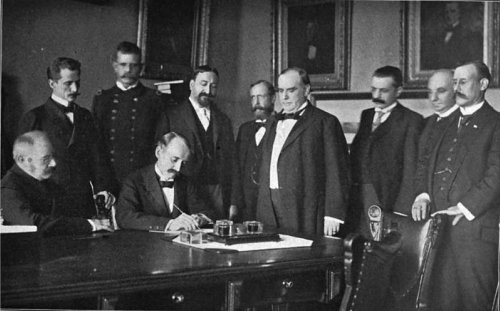Aug. 13, 1898: Mock Battle of Manila
The mock battle of Manila was staged on August 13. At 7:30 a.m., with American and Spanish commanders unaware that a peace protocol had been signed between their governments a few hours earlier, the battle for Manila commenced. Admiral Dewey had cut the only cable that linked Manila to the outside world on May 2nd; news of the war’s end reached neither General Jaudenes or Admiral Dewey until August 16th.
Capt. Thomas Bentley Mott, aide to Maj. Gen. Wesley Merritt, wrote: “…the bugle sounded the advance, the whole camp sent up a tremendous cheer, showing that neither rain, the darkness of the night, nor the unseen foe could dampen the involuntary delight of the men at the idea of at last getting at their enemy.”
General MacArthur’s 1st Brigade began its movement towards the Spanish positions on the road leading to Pasay. The terrain was swampy, the roads muddy, but by 8:05 a.m. most of the elements had reached their forward positions and taken shelter for the opening volley.
Less than a mile to the west, General Greene’s 2nd Brigade was making its advance along the beach. Leading the way was the 1st Colorado Volunteer Infantry Regiment, followed by volunteer regiments from California, Nebraska, Utah, Pennsylvania, and Oregon. Ahead lay the Spanish fortification at Malate district, Fort San Antonio de Abad.
At 9:45 a.m., two of Admiral George Dewey’s ships (the cruiser Olympia and the gunboat Petrel) began bombarding Fort San Antonio de Abad. There was only sporadic and light return fire. As the 1st Colorado Volunteers neared its walls, the naval bombardment stopped.
The fort was deserted, save for two dead and two wounded Spaniards.
At 10:35 a.m. Capt. Alexander M. Brooks of Denver, Colorado raised the Stars and Stripes over the captured fort.
As the naval bombardment ended and the American forces continued north in two columns, the Filipinos — who had not been apprised of the script —raced to join the battle. They thought there was a real battle going on that would liberate their capitol and they did not want to be left out.
The Filipinos assaulted from four directions – the column of General Pio del Pilar took Sampaloc district; that of General Gregorio del Pilar took Tondo district, that of General Mariano Noriel took Singalong and Paco districts; that of General Artemio Ricarte routed the Spaniards in Sta. Ana district and pursued them all the way to Intramuros.
General Greene’s 2nd Brigade left Malate and continued along the beach.
Meanwhile, in the east, MacArthur’s 1st Brigade moved through the Spanish trenches, overran Blockhouse #14, and confronted the Spanish position at Blockhouse #20 near Singalong.
The church at Singalong district, Manila, where the Astor Battery and 13th Minnesota Volunteers engaged the Spanish behind entrenchments
When the 1st Brigade’s 13th Minnesota Volunteers approached, the Spanish defenders fired a few rounds in a token resistance. It was met by a similarly light return fire from the Americans. Hearing the sound of the skirmish, the Filipinos rushed into the foray. A pitched battle ensued, the soldiers of the 13th Minnesota caught in a cross-fire between the Spaniards ahead of them and the Filipino forces behind them.
The men of the Astor Battery charged the stronghold in a pistol attack which saw the Spanish withdraw. It was probably at Blockhouse #20 that the Americans prohibited the Filipinos from proceeding any farther, and MacArthur’s advance the rest of the way to the central city was unopposed.
At 11:00 a.m., as the two American columns converged on Intramuros, Admiral Dewey hoisted the international signal flag “Do you surrender?”.
Meanwhile, General Greene and his troops had reached the Luneta, the city promenade (ABOVE, pre-war 1890’s), where they were confronted with a heavily defended blockhouse, and a group of Spanish soldiers who, like the Filipinos, apparently were not privy to the unfolding script.
At 11:45 a.m., the Belgian consul’s launch drew alongside the Olympia. Consul Edouard Andre (LEFT) conferred with Admiral Dewey.
Flag Lt. Thomas Brumby took the largest American flag on the ship and went aboard the launch. The launch steamed away toward Manila, 1,500 yards away.
At 12:00 p.m., the international signal “C.F.L.”, meaning “Hold conference”, was hoisted over the city walls.
At 2:33 p.m., Lt. Brumby returned and reported that the Spaniards would surrender as soon as General Merritt got 600 to 700 American troops inside Intramuros to protect them from the Filipinos. Admiral Dewey ordered Lt. Brumby to tell General Merritt that he agreed to anything.
The Americans rushed into Intramuros.
At 5:45 p.m., the Spanish flag went down and Lt. Brumby (ABOVE, in 1898) hoisted the huge American flag in its place. The 2nd Oregon band struck up “The Star-Spangled Banner” while the Spanish women wept. The ships of the US fleet saluted the new flag with 21 guns each. In ten minutes 189 saluting charges were fired.
At 6:00 p.m., the band on the Olympia struck up “The Victory of Manila”.
Terms of capitulation were promptly agreed upon between American and Spanish commanders and the occupation of the Spanish capital of the Philippines was complete. The Americans at once began to fraternize with their Spanish counterparts.
